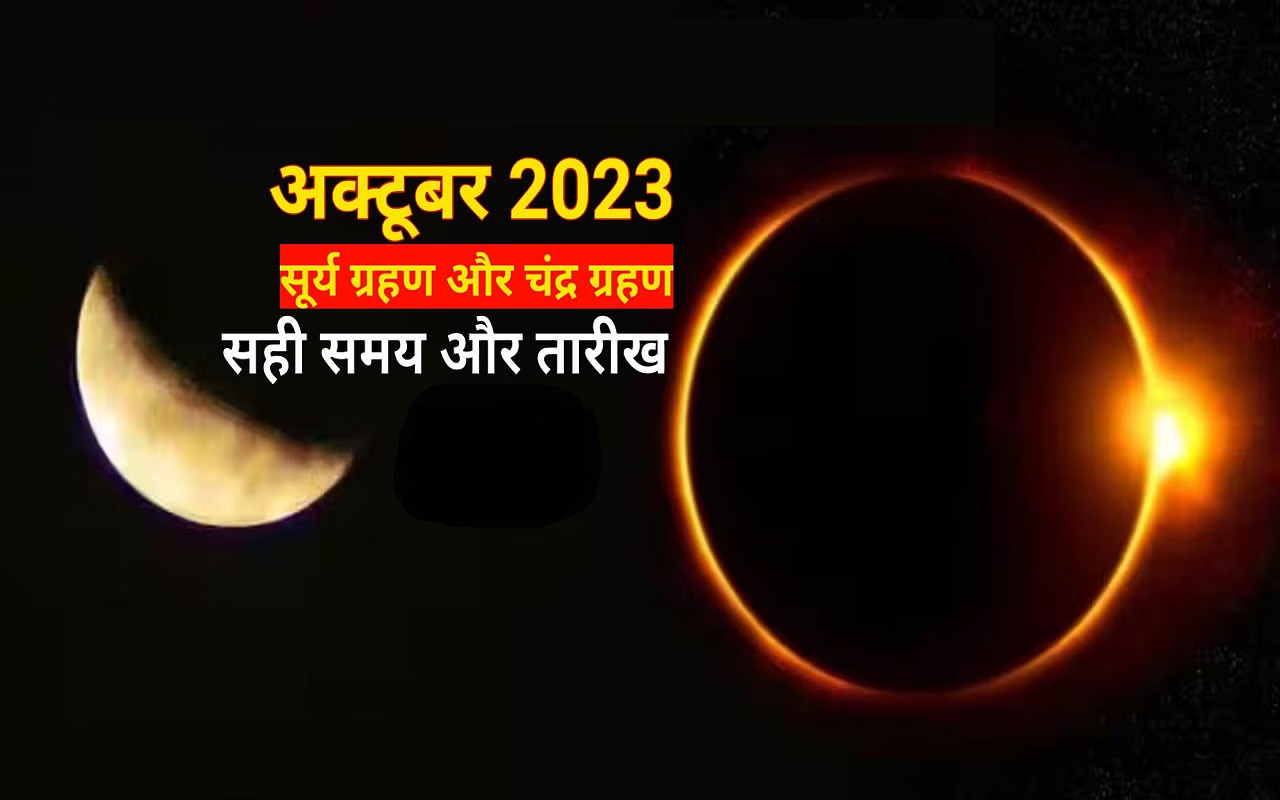Surya Grahan, Chandra Grahan 2023: Solar And Lunar Eclipse Dates Revealed- Hum Hindu
सूर्य ग्रहण, चंद्र ग्रहण 2023: अक्टूबर में सूर्य और चंद्र ग्रहण की तारीखें, देखने के लिए कब और कहाँ

इस अक्टूबर में, आसमान में घटित होने वाले ग्रहणों के अद्वितीय सौंदर्य का आनंद लें! हम आपको बता रहे हैं 2023 में आगामी सूर्य ग्रहण और चंद्र ग्रहण की तारीखें और उन्हें कैसे और कहाँ देख सकते हैं।
1. सूर्य ग्रहण (Solar Eclipse) 2023:
इस अक्टूबर में, सूर्य ग्रहण का आयोजन हो रहा है जो दृश्य में बदलाव लाएगा। यहां है सूर्य ग्रहण की तारीख और वक्त:
- तारीख: 17 अक्टूबर 2023
- कहाँ देखें: इस ग्रहण को देखने के लिए आपको एक बिना किसी खास सुरक्षा के भी सूजी की छलने वाली चश्मा पहनना होगा और इसे सूर्य की धुप में न देखें।
2. चंद्र ग्रहण (Lunar Eclipse) 2023:
इस अक्टूबर, एक ब्रह्मांडिक नृत्य में शामिल हों! चंद्र ग्रहण की तारीख और वक्त यहाँ हैं:
- तारीख: 31 अक्टूबर 2023
- कहाँ देखें: चंद्र ग्रहण को देखने के लिए आपको खुले आकाश के नीचे जाने की आवश्यकता होती है, जो कि विचारणीय दृश्य प्रदान करेगा।
यदि आप ब्रह्मांड के इस अद्वितीय दर्शन का आनंद लेना चाहते हैं, तो इन ग्रहणों के समय और जगह की तैयारी करें और इन अद्वितीय घटनाओं का आनंद उठाएं!
Surya Grahan, Chandra Grahan 2023: Solar And Lunar Eclipse Dates Revealed
The celestial calendar for October 2023 is marked by significant celestial events—Surya Grahan (Solar Eclipse) and Chandra Grahan (Lunar Eclipse). These astronomical phenomena never fail to captivate skywatchers worldwide. Here, we provide you with essential details on the dates, times, and locations for observing these eclipses.
Solar Eclipse 2023: When and Where to Witness the Phenomenon
Date: October 2, 2023 Time: Starting at 04:30 AM UTC Visibility: The solar eclipse will be visible from North America, Europe, and parts of Asia. The degree of visibility varies by location.
The solar eclipse of 2023 promises to be a spectacular sight for those in the northern hemisphere. Make sure to use proper eye protection while viewing this awe-inspiring event. Special solar eclipse glasses or indirect viewing methods are recommended.
Lunar Eclipse 2023: A Celestial Delight in October
Date: October 16, 2023 Time: Beginning at 18:45 PM UTC Visibility: Lunar eclipses are visible from a broader range of locations compared to solar eclipses. This one will be observable from most parts of the world, including the Americas, Europe, Asia, and Australia.
Lunar eclipses are often referred to as the “Blood Moon” due to the reddish tint that the Moon takes on during totality. It’s a breathtaking spectacle that can be observed with the naked eye, making it accessible to a wide audience of sky enthusiasts.
Safety Precautions for Eclipse Viewing
While witnessing these celestial events can be captivating, it’s crucial to prioritize safety. Here are some key points to keep in mind:
-
Use Proper Eye Protection: When observing a solar eclipse, protect your eyes with certified solar eclipse glasses or use indirect viewing methods like pinhole projectors.
-
Don’t Stare Directly at the Sun: Never look directly at the Sun during a solar eclipse without proper protection. Serious eye damage can result.
-
Find a Dark Spot: For lunar eclipses, try to watch from a location with minimal light pollution for the best experience.
-
Stay Informed: Check local news and astronomical sources for precise timing and visibility details for your location.
These celestial events offer a unique opportunity to connect with the wonders of the universe. Whether you’re an avid stargazer or just someone curious about the cosmos, mark your calendar for the October 2023 solar and lunar eclipses—a celestial show you won’t want to miss.
A solar eclipse occurs when the moon passes between the Earth and the Sun, temporarily blocking out the Sun’s light. It creates a temporary darkening of the daytime sky.
The solar eclipse is scheduled for October 17, 2023.
To safely observe a solar eclipse, you should use eclipse glasses or a solar viewer specifically designed for this purpose. Never look directly at the Sun during an eclipse without proper eye protection, as it can cause eye damage.
A lunar eclipse occurs when the Earth comes directly between the Sun and the Moon, causing the Earth’s shadow to be cast on the Moon, giving it a reddish appearance.
The lunar eclipse is scheduled for October 31, 2023.
Yes, you can watch a lunar eclipse with the naked eye as it is safe to view. Unlike a solar eclipse, you don’t need special eye protection to observe a lunar eclipse.
The visibility of eclipses depends on your geographical location. It’s best to check with local astronomy clubs or online resources to determine the visibility of these eclipses in your area.
Solar and lunar eclipses occur several times a year but are not visible from all parts of the world. The frequency and visibility of eclipses vary.
Yes, many cultures have myths, stories, and beliefs associated with solar and lunar eclipses. These often vary from one culture to another.
You can find detailed information about upcoming eclipses, including their visibility and timing, from reputable astronomy websites, local planetariums, and astronomical organizations.
